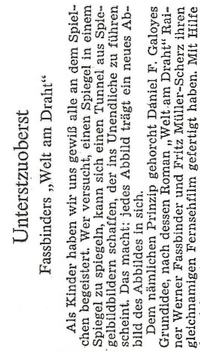 |
| |
Topsy-turvy
Fassbinder’s “World on a Wire”
I am sure we all loved this game when we were kids: look at your reflection in a mirror and you can create a whole series of mirror images that appear to continue ad infinitum. In essence each image is a new image of the image in itself.
This is Daniel F. Galouye’s very basic principle. Rainer Werner Fassbinder and Fritz Müller-Scherz base their TV movie “World on a Wire” on his novel. A multitude of circuits — entitled units of identity, contact, and of projection — enable the electronic monster Simulacron to create a simulated “lower” world out of an “upper” world. Reality is the same on both levels; consequently, the electronically manipulated lower world has identical technical standards and hence is capable — with the aid of Simulacron — of creating yet another “lower” world. This continues along a string of logical parameters that return us to our childhood tunnel of mirror reflections and its world within a world within a world and ultimate infinity. The specific thrill — apart from the utopian game model and the options for developing action — is due to the fact that the particular “inhabitants”, who all live in a firmly defined world, are unable to determine, based on their environment, where top and bottom are located. They cannot figure out whether they are inanimate circuits with a preconceived momentum or so-called real living beings.
Here we have science fiction that is, for once, not a galactic journey in a wildly flying space ship. Instead we see an electrifying mix between thought stimulation, adventure and He-man-bravura. This broad palette of offerings is likely to appeal to almost all viewers. The story of “World on a Wire” is open to all interpretations, be they philosophical, Christian, historic, economical or social ideas and the mechanism of our society. It seems that certain events in our reality are thus put into perspective and that we are invited to re-interpret them. Thanks to this openness, we have come to agree that this film is fascinating.
A product with such mass appeal as an entertainment film forced Fassbinder to make concessions. One is the “Happy Ending”; another is the rather conventionally conceived and overlong chase of the bad guys in part two, where we encounter Klaus Löwitsch as a small version of Mannix. Despite this criticism, the film is completely coherent and convincing. It was a lot of fun and an intellectual joy to see this director handle his complicated story with such cheeky ease and to note that he still found time to indulge in favorite poses and quotes (especially wonderful is the reference to “Cabaret”).
The “Fassbinder-circuit” must have fallen into the hands of a genius programmer, because simply everything was right in this “World on a Wire”: The use of the well-known and dependable Fassbinder actors as well as every single surprising guest appearance (Eddie Constantine, Rainer Langhans, Christine Kaufmann in small cameos), the cinematography (Michael Ballhaus), at times the music formed quite a deliberate counterpoint (Gottfried Hüngsberg). The final highpoint is the cunning quotation of Peter Zadek’s TV film “Der Pott” (Karl Heinz Vosgerau’s mumbo-jumbo as the singing physician in the Simulacron.) The entire project had the kind of force popular TV programs attain at most once a year. It seems that Fassbinder has now definitely left his obstreperous past behind.
HANS-DIETER SEIDEL
Stuttgarter Zeitung, October 18, 1973
back
|
|
|
 |